This article needs additional citations for verification .(January 2021) |

| Part of a series on |
| Musical instruments |
|---|
An electric ukulele is a ukulele which is electrically amplified, via either piezoelectric or magnetic pickups.
This article needs additional citations for verification .(January 2021) |

| Part of a series on |
| Musical instruments |
|---|
An electric ukulele is a ukulele which is electrically amplified, via either piezoelectric or magnetic pickups.
A solid-body electric ukulele produces very little sound acoustically, requiring an amplifier to be heard from more than a few feet away. Some solid-body electric ukuleles have steel strings and active humbucker style or single-coil magnetic pickups, while other electric ukuleles are solid-body electric ukuleles with nylon strings and piezoelectric pick-ups under the saddle.
An electro-acoustic ukulele is a standard acoustic instrument to which a passive pickup has been added, a method similar to that used for an acoustic-electric guitar. Such ukuleles have nylon or gut strings, not the metal strings necessary for ukuleles with magnetic pickups. Electro-acoustic ukuleles may be played either unplugged or plugged into an amplifier. The acoustic and electric tone qualities will often differ between electric ukuleles, with some electro-acoustic ukuleles being built with the primary aim of producing quality sound when amplified rather than a consistent acoustic sound.
The electric lap steel ukulele is an uncommon instrument, consisting of a small ukulele-shaped solid-body which is laid in the artist's lap. It has four strings raised above the neck, which are not pressed down onto a fretboard, but are played with a steel slide.
An electric lap steel ukulele is essentially a small lap steel guitar with only four strings. Similar instruments have been built by custom instrument makers, but the only production manufacturer was Jupiter Creek Music (Australia) before they closed their business in October 2012.
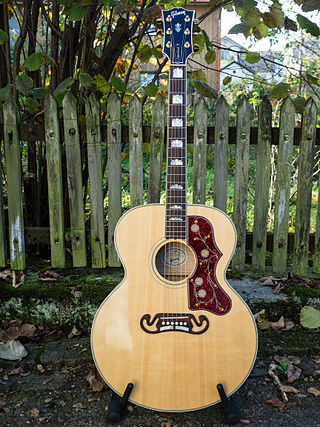
The steel-string acoustic guitar is a modern form of guitar that descends from the gut-strung Romantic guitar, but is strung with steel strings for a brighter, louder sound. Like the modern classical guitar, it is often referred to simply as an acoustic guitar, or sometimes as a folk guitar.

An electric guitar is a guitar that requires external amplification in order to be heard at typical performance volumes, unlike a standard acoustic guitar. It uses one or more pickups to convert the vibration of its strings into electrical signals, which ultimately are reproduced as sound by loudspeakers. The sound is sometimes shaped or electronically altered to achieve different timbres or tonal qualities from that of an acoustic guitar via amplifier settings or knobs on the guitar. Often, this is done through the use of effects such as reverb, distortion and "overdrive"; the latter is considered to be a key element of electric blues guitar music and jazz, rock and heavy-metal guitar-playing. Designs also exist combining attributes of the electric and acoustic guitars: the semi-acoustic and acoustic-electric guitars.

The guitar is a stringed musical instrument, that is usually fretted and typically has six or twelve strings. It is usually held flat against the player's body and played by strumming or plucking the strings with the dominant hand, while simultaneously pressing selected strings against frets with the fingers of the opposite hand. A guitar pick may also be used to strike the strings. The sound of the guitar is projected either acoustically, by means of a resonant hollow chamber on the guitar, or amplified by an electronic pickup and an amplifier.

An electric piano is a musical instrument that has a piano-style musical keyboard, where sound is produced by means of mechanical hammers striking metal strings or reeds or wire tines, which leads to vibrations which are then converted into electrical signals by pickups. The pickups are connected to an instrument amplifier and loudspeaker to reinforce the sound sufficiently for the performer and audience to hear. Unlike a synthesizer, the electric piano is not an electronic instrument. Instead, it is an electro-mechanical instrument. Some early electric pianos used lengths of wire to produce the tone, like a traditional piano. Smaller electric pianos used short slivers of steel to produce the tone. The earliest electric pianos were invented in the late 1920s; the 1929 Neo-Bechstein electric grand piano was among the first. Probably the earliest stringless model was Lloyd Loar's Vivi-Tone Clavier. A few other noteworthy producers of electric pianos include Baldwin Piano and Organ Company, and the Wurlitzer Company.

The acoustic bass guitar is a bass instrument with a hollow wooden body similar to, though usually larger than, a steel-string acoustic guitar. Like the traditional electric bass guitar and the double bass, the acoustic bass guitar commonly has four strings, which are normally tuned E-A-D-G, an octave below the lowest four strings of the 6-string guitar.

An instrument amplifier is an electronic device that converts the often barely audible or purely electronic signal of a musical instrument into a larger electronic signal to feed to a loudspeaker. An instrument amplifier is used with musical instruments such as an electric guitar, an electric bass, electric organ, electric piano, synthesizers and drum machine to convert the signal from the pickup or other sound source into an electronic signal that has enough power, due to being routed through a power amplifier, capable of driving one or more loudspeaker that can be heard by the performers and audience.
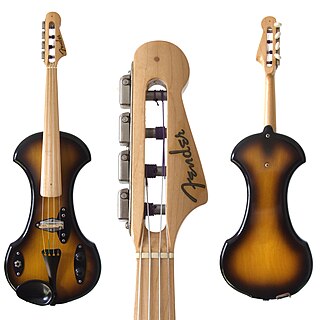
An electric violin is a violin equipped with an electronic output of its sound. The term most properly refers to an instrument intentionally made to be electrified with built-in pickups, usually with a solid body. It can also refer to a violin fitted with an electric pickup of some type, although "amplified violin" or "electro-acoustic violin" are more accurate then.
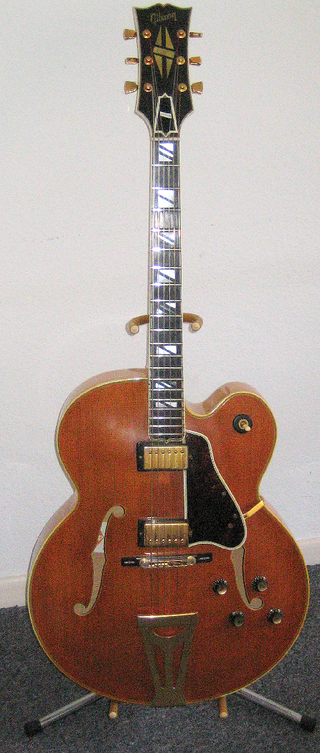
An archtop guitar is a hollow acoustic or semi-acoustic guitar with a full body and a distinctive arched top, whose sound is particularly popular with jazz, blues, and rockabilly players.

Jazz bass is the use of the double bass or electric bass guitar to improvise accompaniment ("comping") basslines and solos in a jazz or jazz fusion style. Players began using the double bass in jazz in the 1890s to supply the low-pitched walking basslines that outlined the chord progressions of the songs. From the 1920s and 1930s Swing and big band era, through 1940s Bebop and 1950s Hard Bop, to the 1960s-era "free jazz" movement, the resonant, woody sound of the double bass anchored everything from small jazz combos to large jazz big bands.

A pickup is a transducer that captures or senses mechanical vibrations produced by musical instruments, particularly stringed instruments such as the electric guitar, and converts these to an electrical signal that is amplified using an instrument amplifier to produce musical sounds through a loudspeaker in a speaker enclosure. The signal from a pickup can also be recorded directly.

The electric upright bass (EUB) is an instrument that can perform the musical function of a double bass. It requires only a minimal or 'skeleton' body to produce sound because it uses a pickup and electronic amplifier and loudspeaker. Therefore, a large resonating structure is not required to project the sound into the air. This minimal body greatly reduces the bulk and weight of the instrument. EUBs must always be connected to an amplifier and speaker cabinet to produce an adequate audible sound. The EUB retains enough of the features of the double bass so that double bass players are able to perform on it.
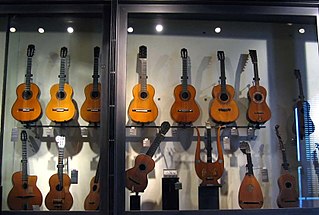
The following outline is provided as an overview of and topical guide to guitars:
A solid-body musical instrument is a string instrument such as a guitar, bass or violin built without its normal sound box and relying on an electromagnetic pickup system to directly detect the vibrations of the strings; these instruments are usually plugged into an instrument amplifier and loudspeaker to be heard. Solid-body instruments are preferred in situations where acoustic feedback may otherwise be a problem and are inherently both less expensive to build and more rugged than acoustic electric instruments.

A resonator guitar or resophonic guitar is an acoustic guitar that produces sound by conducting string vibrations through the bridge to one or more spun metal cones (resonators), instead of to the guitar's sounding board (top). Resonator guitars were originally designed to be louder than regular acoustic guitars, which were overwhelmed by horns and percussion instruments in dance orchestras. They became prized for their distinctive tone, and found life with bluegrass music and the blues well after electric amplification solved the problem of inadequate volume.
An acoustic guitar is a musical instrument in the string family. When a string is plucked, its vibration is transmitted from the bridge, resonating throughout the top of the guitar. It is also transmitted to the side and back of the instrument, resonating through the air in the body, and producing sound from the sound hole. While the original, general term for this stringed instrument is guitar, the retronym 'acoustic guitar' – often used incorrectly to indicate the steel stringed model – distinguishes it from an electric guitar, which relies on electronic amplification. Typically, a guitar's body is a sound box, of which the top side serves as a sound board that enhances the vibration sounds of the strings. In standard tuning the guitar's six strings are tuned (low to high) E2 A2 D3 G3 B3 E4.

The Rickenbacker Electro A-22, nicknamed the "Frying Pan" is the first electric lap steel guitar, also widely considered to be the first commercially successful electric guitar. Developed in 1931/1932, it received its patent in August 1937. A previous attempt, the Stromberg company‘s transducer-based "Stromberg Electro", was introduced in 1928. It used a "vibration-transfer rod" from the instrument's sounding board attached to magnets inside the guitar, and was not successful. George Beauchamp created the "Fry-Pan" in 1931, and it was subsequently manufactured by Electro String Instrument Corporation under the name Electro, later named Rickenbacker. The instrument gained its nickname because its circular body and long neck make it resemble a frying pan.
Electric guitar design is a type of industrial design where the looks and efficiency of the shape as well as the acoustical aspects of the guitar are important factors. In the past many guitars have been designed with various odd shapes as well as very practical and convenient solutions to improve the usability of the object.
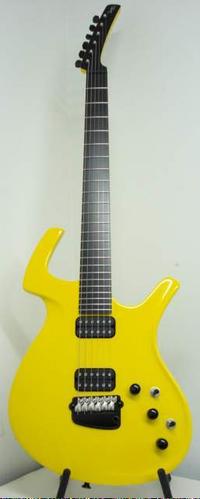
The Parker Fly was a model of electric guitar built by Parker Guitars. It was designed by Ken Parker and Larry Fishman, and first produced in 1993. The Fly is unique among electric guitars in the way it uses composite materials. It is notable for its light weight and resonance. It was also one of the first electric guitars to combine traditional magnetic pickups with piezoelectric pickups, allowing the guitarist to access both acoustic and electric tones. Production ended in 2016 and the company has not released a new model of any kind since.
Classical electric guitars, also known as nylon-string electric guitars, represent a unique fusion of traditional classical guitar design and modern electric guitar technology. These instruments combine the rich and warm tonal qualities of nylon-stringed classical guitars with the versatility and amplified sound capabilities of electric guitars. By integrating nylon strings with onboard electronics, pickups, and preamp systems, classical electric guitars offer musicians a wide range of sonic possibilities for various musical genres and performance settings.

Electric or electro-acoustic bagpipes refers to any set of bagpipes designed to use a pickup to detect the mechanical vibrations of the reed or reeds. As with an electric guitar, the detected electrical signal is then routed to an amplifier, and from there to a loudspeaker. Depending on the volume of the amplified sound, the unamplified acoustic sound of the bagpipe will also be heard to some extent alongside it.